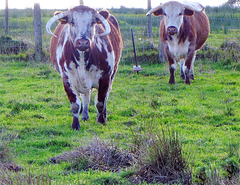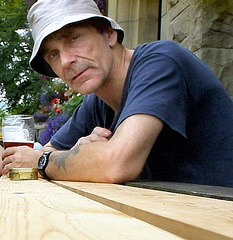Phil's photos with the keyword: Barley
Fairy and Woodpecker.
| 07 Dec 2019 |
|
|
|
A fairy "hitch-hiker" riding a woodpecker....another sculpture in Aitken Wood near the village of barley in Pendle District, North-West England (see links below). Photographed with a Nikon D500 camera and processed with Nikon Capture NX2.
btckstorage.blob.core.windows.net/site5828/Panel/Pendle_Sculpture_Trail_leaflet_2013_FINAL.pdf
www.tripadvisor.co.uk/Attraction_Review-g3555319-d7134467-Reviews-Pendle_Sculpture_Trail-Barley_Lancashire_England.html
Wishing chair.
| 07 Dec 2019 |
|
|
|
The "Wishing chair" (a.k.a. the "Magic chair" / the "Living chair") is one of the Pendle Sculpture Trail creations in Aitken Wood near the village of barley in North-West England. I'm not sure what the "official" name of this sculpture is but, whatever the name, it provides a great place to take a rest after climbing the steep path to the woods.
Camera: Nikon D500.
Software: Nikon Capture NX2.
More Information / photos at link below:
www.tripadvisor.co.uk/Attraction_Review-g3555319-d7134467-Reviews-Pendle_Sculpture_Trail-Barley_Lancashire_England.html
Grim.
| 07 Dec 2019 |
|
|
|
This mythical beast (whose name is "Grim") is, according to the myth, a friend of "The Boggart".....see my earlier photo. This is one of the sculptures in Aitken Wood near the town of Barley in Lancashire, North-West England. See link below.
Photographed with a Nikon D500 camera.
Processed with Nikon Capture NX2.
www.tripadvisor.co.uk/Attraction_Review-g3555319-d7134467-Reviews-Pendle_Sculpture_Trail-Barley_Lancashire_England.html
Delta T (ΔT).
| 04 Dec 2019 |
|
|
|
This sculpture was named "ΔT" which I interpreted to mean "Changing times".....the Greek letter Delta usually refers (in mathematics) to a change of something. The dates are those which are / were significant in British and / or local history and they range from 1307 to 2018 which is when this sculpture was created. This is one of the many sculptures along the Pendle Sculpture Trail near the village of Barley in Lancashire, North-West England (link below).
Photographed with a Nikon D500 camera.
Processed with Nikon Capture NX2.
Lens: AF-S DX Zoom-Nikkor 17-55mm f/2.8G IF-ED
www.tripadvisor.co.uk/Attraction_Review-g3555319-d7134467-Reviews-Pendle_Sculpture_Trail-Barley_Lancashire_England.html
Pendle view.
| 25 Nov 2019 |
|
|
|
Pendle Hill viewed from Aitken Wood (the location of the Pendle Sculpture Trail) near the village of Barley in Lancashire, North-West England.
Photographed with a Nikon D500 camera and processed with Nikon Capture NX 2 software.
Totem.
| 22 Nov 2019 |
|
|
|
One of the sculptures situated along the Pendle Sculpture Trail in Aitken Wood near the village of Barley in Lancashire, England (link below).
Photographed with a Nikon D500 camera and processed with Nikon Capture NX2 software.
www.tripadvisor.co.uk/Attraction_Review-g3555319-d7134467-Reviews-Pendle_Sculpture_Trail-Barley_Lancashire_England.html
Unicorn.
| 22 Nov 2019 |
|
|
|
In European folklore the unicorn is often depicted as a white horse-like or goat-like animal with a long horn and cloven hooves (sometimes a goat's beard). In the Middle Ages and Renaissance it was commonly described as an extremely wild woodland creature, a symbol of purity and grace which could be captured only by a virgin. In the encyclopedias its horn was said to have the power to render poisoned water potable and to heal sickness. In medieval and Renaissance times the tusk of the narwhal was sometimes sold as unicorn horn. The unicorn continues to hold a place in popular culture. It is often used as a symbol of fantasy or rarity.
(Wikipedia).
Camera: NIkon D500
Lens: AF-S DX Zoom-Nikkor 17-55mm f/2.8G IF-ED
Software: Nikon Capture NX2
Photographed at the Pendle Sculpture Trail:
www.tripadvisor.co.uk/Attraction_Review-g3555319-d7134467-Reviews-Pendle_Sculpture_Trail-Barley_Lancashire_England.html
Boggart.
| 22 Nov 2019 |
|
|
|
The recorded folklore of Boggarts is remarkably varied as to their appearance and size. Many are described as relatively human-like in form, though usually uncouth, very ugly and often with bestial attributes. One such boggart was "a squat hairy man, strong as a six year old horse with arms almost as long as tacklepoles". Other accounts give a more completely beast-like form. The "Boggart of Longar Hede" from Yorkshire was said to be a fearsome creature the size of a calf, with long shaggy hair and eyes like saucers. It trailed a long chain after itself, which made a noise like the baying of hounds. The "Boggart of Hackensall Hall" in Lancashire had the appearance of a huge horse. At least one Lancashire boggart could take the form of various animals, or indeed more fearful creatures.
(Wikipedia).
Camera: Nikon D500
Software: Nikon Capture NX2
Photographed at the Pendle Sculpture Trail:
www.tripadvisor.co.uk/Attraction_Review-g3555319-d7134467-Reviews-Pendle_Sculpture_Trail-Barley_Lancashire_England.html
HFF: The road to Pendle Hill.
| 22 Nov 2019 |
|
|
|
Pendle Hill viewed from Black Moss near the village of Barley in Lancashire, England. Photographed with a Nikon D500 camera and processed with Nikon Capture NX2.
English Longhorn.
| 09 Oct 2014 |
|
|
|
English Longhorn cattle are a long-horned brown and white breed of beef cattle originating from the Craven area in the North-West of England. The breed was initially used as a draught animal which its body is well suited for; the milk was also collected for butter and cheese because of its high butterfat content. An individual farmer would have owned one or two cows; these would have been accompanied by a bull owned by the Lord of the Manor. The long, curved horns that serve to distinguish this breed from others can make an individual appear aggressive, although by temperament they are usually friendly. Longhorns live surprisingly longer than other breeds of cattle and are also known for calving with ease. They have a white patch along the line of their spine and under their bellies. They are not to be confused with the Texas longhorn breed which is also often called "Longhorn cattle" or "Longhorns".
Though long-horned oxen were already predominant in Craven in the 16th and 17th centuries, the English Longhorn breed was much improved for beef by Robert Bakewell of Dishley when large amounts of meat were needed to feed people who had moved to towns and cities in the Industrial Revolution. His selective breeding made the "Dishley Longhorn" very popular towards the end of the 18th century. The breed is still to be found in Leicestershire at the Stanley's Springbarrow Farm, Freddie de Lisle's Quenby Hall and a small herd has been re-introduced at Calke Abbey in Derbyshire where the Harpur-Crewe family had traditionally kept them.
(Wikipedia).
English Longhorn cattle.
| 06 Oct 2014 |
|
|
|
English Longhorn cattle are a long-horned brown and white breed of beef cattle originating from the Craven area in the North-West of England. The breed was initially used as a draught animal which its body is well suited for; the milk was also collected for butter and cheese because of its high butterfat content. An individual farmer would have owned one or two cows; these would have been accompanied by a bull owned by the Lord of the Manor. The long, curved horns that serve to distinguish this breed from others can make an individual appear aggressive, although by temperament they are usually friendly. Longhorns live surprisingly longer than other breeds of cattle and are also known for calving with ease. They have a white patch along the line of their spine and under their bellies. They are not to be confused with the Texas longhorn breed which is also often called "Longhorn cattle" or "Longhorns".
Though long-horned oxen were already predominant in Craven in the 16th and 17th centuries, the English Longhorn breed was much improved for beef by Robert Bakewell of Dishley when large amounts of meat were needed to feed people who had moved to towns and cities in the Industrial Revolution. His selective breeding made the "Dishley Longhorn" very popular towards the end of the 18th century. The breed is still to be found in Leicestershire at the Stanley's Springbarrow Farm, Freddie de Lisle's Quenby Hall and a small herd has been re-introduced at Calke Abbey in Derbyshire where the Harpur-Crewe family had traditionally kept them.
(Wikipedia).
Sunlight on Pendle Hill.
| 22 Jul 2013 |
|
|
|
The Eastern side of Pendle Hill in early Autumn sunlight, photographed from near the village of Barley in Lancashire, England. Camera Nikon D90 with the "kit" 18-105mm lens. Just over the hill (to the right) is the village of Downham where most of the film "Whistle Down the Wind" was filmed in 1961.....Pendle Hill can frequently be seen in the background during many scenes in the film.
NOTE.
www.ipernity.com/group/england
Chilling out.
| 24 May 2013 |
|
|
|
Just me...."chilling".
Photographed at The Pendle Inn in Barley, Lancashire.
Camera: Nikon D90.
Software: Nikon Capture NX2.
You looking at me....?
| 06 Jun 2013 |
|
|
|
Near Barley, Lancashire.
Camera Nikon D90 with the excellent AFS Nikkor 18-105mm "kit" lens....one of the first photos I took with this camera.
www.ipernity.com/group/alphabet-site
Jump to top
RSS feed- Phil's latest photos with "Barley" - Photos
- ipernity © 2007-2025
- Help & Contact
|
Club news
|
About ipernity
|
History |
ipernity Club & Prices |
Guide of good conduct
Donate | Group guidelines | Privacy policy | Terms of use | Statutes | In memoria -
Facebook
Twitter














